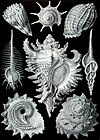Portal:Gastropods/Selected biography
This page is where the biographies to be featured on the Gastropods portal are listed. There are many (mostly very short) biographical articles listed at List of malacologists.
Selected biography 1
Portal:Gastropods/Selected biography/1

In 1869 Tryon became the conservator in the malacological section. In 1879 he started the Manual of Conchology; structural and systematic; with illustrations of the species, volume 1, series 1. When he died, nine volumes of the first series had been published. After his death Henry Augustus Pilsbry continued this work for the next 47 years. (Read more...)
Selected biography 2
Portal:Gastropods/Selected biography/2

He was especially expert in the land snail families Streptaxidae, Achatinidae and Maizaniidae, and as of 2008, had written 655 scientific publications. (Read more...)
Selected biography 3
Portal:Gastropods/Selected biography/3

In 1816 Swainson accompanied the explorer Henry Koster to Brazil. They did not spend a long time on shore because of a revolution, but Swainson returned to England in 1818 in his words "a bee loaded with honey", with a collection of over 20,000 insects, 1,200 species of plants, drawings of 120 species of fish, and about 760 bird skins. (Read more...)
Selected biography 4
Portal:Gastropods/Selected biography/4
Stephen Jay Gould (September 10, 1941 – May 20, 2002) was an American paleontologist, evolutionary biologist and historian of science. He was also one of the most influential and widely read writers of popular science of his generation. Gould spent most of his career teaching at Harvard University and working at the American Museum of Natural History in New York City. In the latter years of his life, Gould also taught biology and evolution at New York University near his home in SoHo.
Gould's greatest contribution to science was the theory of punctuated equilibrium, which he developed with Niles Eldredge in 1972. Most of Gould's empirical research was based on the land snails Poecilozonites and Cerion, which are endemic to Bermuda and the Caribbean area respectively.
Gould also contributed to evolutionary developmental biology, and has received wide praise for his book Ontogeny and Phylogeny. In evolutionary theory he opposed strict selectionism, sociobiology as applied to humans, and evolutionary psychology. He campaigned against creationism and proposed that science and religion should be considered two distinct fields, or "magisteria", whose authorities do not overlap. (Read more...)
Selected biography 5
Portal:Gastropods/Selected biography/5

Baldwin was born on November 26, 1831 in Honolulu. His father was early missionary doctor Dwight Baldwin (1798–1886), and his mother was Charlotte Fowler Baldwin (1805–1873). After a few years living in Waimea, the family moved to the island of Maui in about 1837. Baldwin lived in Connecticut for a time and received both his undergraduate degree and a Master of Arts from Yale.
In 1890, he moved to Haʻikū, where his younger brother Henry Perrine Baldwin (1842–1911) had founded the agricultural venture Alexander & Baldwin with his brother-in-law Samuel Thomas Alexander (1836–1904). At this time Baldwin devoted much of his efforts to studying mollusks, i.e. to malacology, specifically the study of Hawaiian land snails, some of which he named and described. In addition, several land snail species in the family Achatinellidae were named in honor of him, as well as a subgenus Baldwinia of the genus Partulina. He produced the first catalog of Hawaiian land snails and freshwater snails in 1893. (Read more...)
Selected biography 6
Portal:Gastropods/Selected biography/6

In 1801, he published Système des animaux sans vertèbres, a major work on the classification of invertebrates, a term he invented. In an 1802 publication, he became one of the first to use the term biology in its modern sense. Lamarck continued his work as a premier authority on invertebrate zoology. He is remembered, at least in malacology, as a taxonomist of very considerable stature, having named and described many hundreds of taxa of gastropods and other mollusks. (Read more...)
Selected biography 7
Portal:Gastropods/Selected biography/7


Ernst Heinrich Philipp August Haeckel (February 16, 1834 – August 9, 1919), also written von Haeckel, was an eminent German biologist, naturalist, philosopher, physician, professor and artist who discovered, described and named thousands of new species, mapped a genealogical tree relating all life forms, and coined many terms in biology, including anthropogeny, ecology, phylum, phylogeny, and the kingdom Protista. Haeckel promoted and popularized Charles Darwin's work in Germany and developed the controversial recapitulation theory ("ontogeny recapitulates phylogeny"), claiming that an individual organism's biological development, or ontogeny, parallels and summarizes its species' entire evolutionary development, or phylogeny. Haeckel coined many now ubiquitous terms including "anthropogeny", "phylum", "phylogeny", "ecology". He proposed the kingdom Protista in 1866. His chief interests lay in evolution and life development processes in general, including development of nonrandom form, which culminated in his beautifully illustrated book Kunstformen der Natur (Art forms of nature), which includes over 100 detailed, multi-colour illustrations of animals and sea creatures, including the shells of a variety of marine gastropods. (Read more...)
- ^ Damkaer, David M. (2002). The Copepodologist's Cabinet: A biographical and bibliographical bistory. Philadelphia: American Philosophical Society. p. 117. ISBN 0-87169-240-6.
